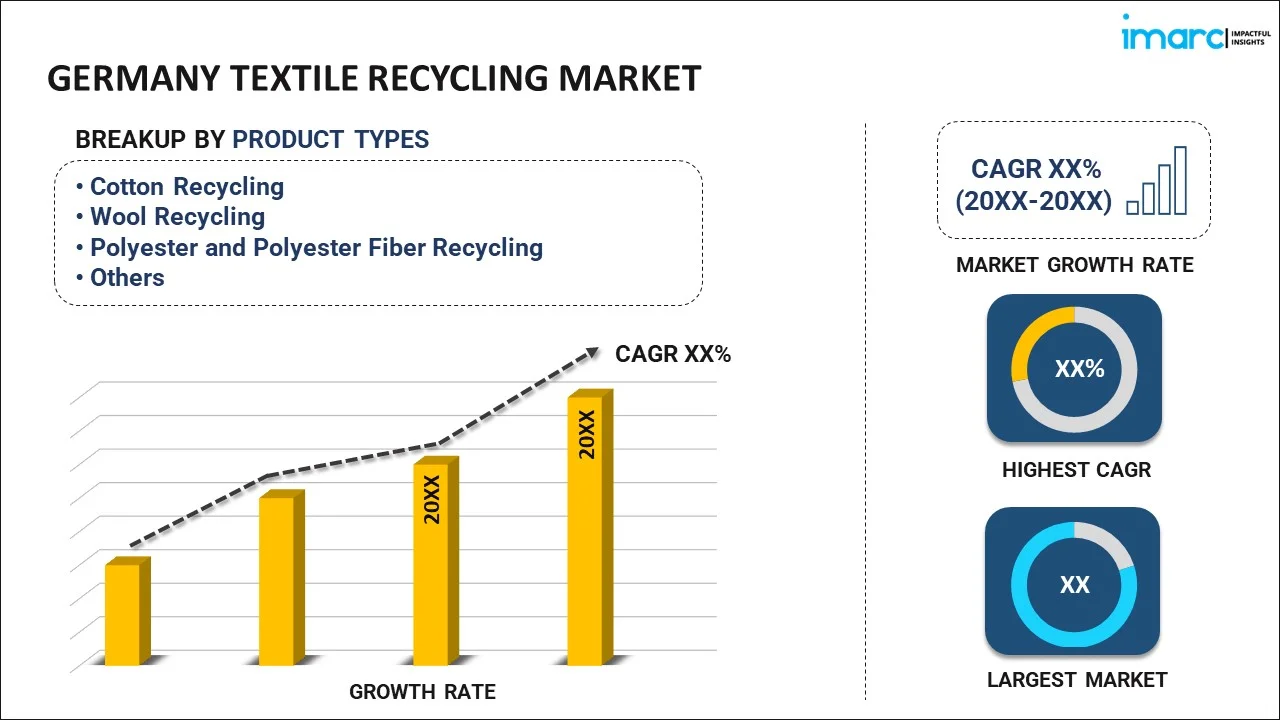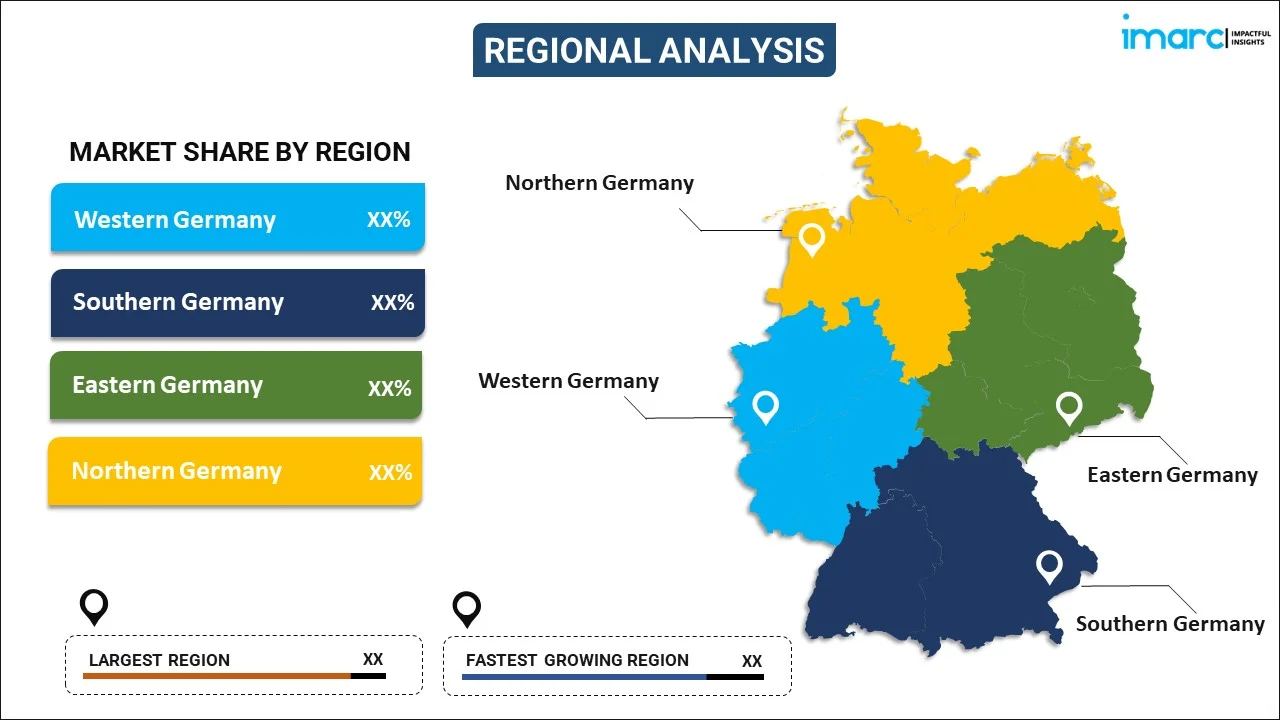
Germany Textile Recycling Market Report by Product Type (Cotton Recycling, Wool Recycling, Polyester and Polyester Fiber Recycling, Nylon and Nylon Fiber Recycling, and Others), Textile Waste (Pre-consumer Textile, Post-consumer Textile), Process (Mechanical, Chemical), End Use (Apparel, Industrial, Home Furnishings, and Others), and Region 2025-2033
Germany Textile Recycling Market Overview:
The Germany textile recycling market size reached USD 242.4 Million in 2024. Looking forward, IMARC Group expects the market to reach USD 302.6 Million by 2033, exhibiting a growth rate (CAGR) of 2.5% during 2025-2033. Germany textile recycling market is mainly driven by rising environmental concerns, supportive government regulations, technological advancements, and collaborative efforts between fashion brands, recycling companies, and nonprofit organizations promoting sustainable practices and circular economy.
|
Report Attribute
|
Key Statistics
|
|---|---|
|
Base Year
|
2024 |
|
Forecast Years
|
2025-2033
|
|
Historical Years
|
2019-2024
|
| Market Size in 2024 | USD 242.4 Million |
| Market Forecast in 2033 | USD 302.6 Million |
| Market Growth Rate (2025-2033) | 2.5% |
Germany Textile Recycling Market Trends:
Rising Environmental Awareness
Rising environmental concerns among consumers and businesses in Germany significantly drives the demand for sustainable practices, including textile recycling. Consumers are becoming more conscious of environmental impact of fast fashion and textile waste leading to a preference for eco-friendly products and brands that prioritize sustainability. In Germany, it is estimated that some 1.01 million tonnes of post-consumer textiles are collected annually, mainly due to a well-established collection network. However, the lack of reliable and uniform data makes it difficult to get a consolidated overview of textile collection rates across EU member states. This shift is propelled by widespread access of information about detrimental effects of textile production on the environment like water pollution, high carbon emissions, and landfill overflow. Businesses, in response to this increasing consumer demand, are adopting more sustainable practices, such as using recycled materials, implementing take-back programs, and ensuring transparency in their supply chains. Additionally, corporate social responsibility (CSR) initiatives are becoming more prevalent, with companies investing in sustainable technologies and recycling processes. This heightened environmental consciousness is fostering a collaborative effort between consumers and businesses to reduce textile waste and promote a circular economy.
Collaborations and Partnerships
Collaborations and partnerships between fashion brands, recycling companies, and nonprofit organizations are fostering a more integrated and effective approach to textile recycling in Germany. Germany has made strides in textile recycling with an 8% increase in textile reuse since year 2015, amounting to 810,000 tonnes and representing 62% of total collected textiles. Fashion brands are increasingly partnering with recycling companies to develop and implement sustainable practices like collecting used garments for recycling and incorporating recycled materials into new products. These collaborations help brands reduce their environmental footprint and meet consumer demand for sustainable fashion. Non-profits play a crucial role by raising awareness, educating the public, and facilitating connections between different stakeholders. They often spearhead initiatives and campaigns that encourage consumers to participate in textile recycling programs. Additionally, non-profits may collaborate with fashion brands to establish collection points, organize recycling events, and develop innovative recycling technologies. These multi-stakeholder partnerships enhance the efficiency and reach of textile recycling efforts, ensuring that more textiles are diverted from landfills and repurposed into valuable resources.
Germany Textile Recycling Market News:
- In 2024, BASF and Inditex have introduced loopamid, a groundbreaking circular nylon 6 made entirely from textile waste. Zara has launched a jacket made exclusively from loopamid, incorporating the material into all components. This innovation supports the fashion industry's move towards circularity and sustainable transformation. BASF and Inditex are aligned in their sustainability goals, aiming to double sales from circular solutions and have 100% of textile products made from environmentally friendly materials by 2030.
- In 2024, Trützschler introduces Truecycled, a comprehensive solution for textile recycling, partnering with Balkan Textile Machinery INC.CO. The system, showcased at ITMA 2023, has garnered significant interest, with manufacturers now adopting the TRUECYCLED line for producing recycled yarns. Dr. Georg Stegschuster emphasizes the importance of a systems approach for achieving high-quality results in textile recycling. Trützschler's holistic system covers the entire process, ensuring optimal quality and minimal fiber shortening.
Germany Textile Recycling Market Segmentation:
IMARC Group provides an analysis of the key trends in each segment of the market, along with forecasts at the country level for 2025-2033. Our report has categorized the market based on product type, textile waste, process, and end use.
Product Type Insights:

- Cotton Recycling
- Wool Recycling
- Polyester and Polyester Fiber Recycling
- Nylon and Nylon Fiber Recycling
- Others
The report has provided a detailed breakup and analysis of the market based on the product type. This includes cotton recycling, wool recycling, polyester and polyester fiber recycling, nylon and nylon fiber recycling, and others.
Textile Waste Insights:
- Pre-consumer Textile
- Post-consumer Textile
A detailed breakup and analysis of the market based on the textile waste have also been provided in the report. This includes pre-consumer textile and post-consumer textile.
Process Insights:
- Mechanical
- Chemical
The report has provided a detailed breakup and analysis of the market based on the process. This includes mechanical and chemical.
End Use Insights:
- Apparel
- Industrial
- Home Furnishings
- Others
A detailed breakup and analysis of the market based on the end use have also been provided in the report. This includes apparel, industrial, home furnishings, and others.
Region Insights:

- Western Germany
- Southern Germany
- Eastern Germany
- Northern Germany
The report has also provided a comprehensive analysis of all the major regional markets, which include Western Germany, Southern Germany, Eastern Germany, and Northern Germany.
Competitive Landscape:
The market research report has also provided a comprehensive analysis of the competitive landscape. Competitive analysis such as market structure, key player positioning, top winning strategies, competitive dashboard, and company evaluation quadrant has been covered in the report. Also, detailed profiles of all major companies have been provided.
Germany Textile Recycling Market Report Coverage:
| Report Features | Details |
|---|---|
| Base Year of the Analysis | 2024 |
| Historical Period | 2019-2024 |
| Forecast Period | 2025-2033 |
| Units | Million USD |
| Scope of the Report | Exploration of Historical Trends and Market Outlook, Industry Catalysts and Challenges, Segment-Wise Historical and Future Market Assessment:
|
| Product Types Covered | Cotton Recycling, Wool Recycling, Polyester and Polyester Fiber Recycling, Nylon and Nylon Fiber Recycling, Others |
| Textile Wastes Covered | Pre-consumer Textile, Post-consumer Textile |
| Processes Covered | Mechanical, Chemical |
| End Uses Covered | Apparel, Industrial, Home Furnishings, Others |
| Regions Covered | Western Germany, Southern Germany, Eastern Germany, Northern Germany |
| Customization Scope | 10% Free Customization |
| Post-Sale Analyst Support | 10-12 Weeks |
| Delivery Format | PDF and Excel through Email (We can also provide the editable version of the report in PPT/Word format on special request) |
Key Questions Answered in This Report:
- How has the Germany textile recycling market performed so far and how will it perform in the coming years?
- What has been the impact of COVID-19 on the Germany textile recycling market?
- What is the breakup of the Germany textile recycling market on the basis of product type?
- What is the breakup of the Germany textile recycling market on the basis of textile waste?
- What is the breakup of the Germany textile recycling market on the basis of process?
- What is the breakup of the Germany textile recycling market on the basis of end use?
- What are the various stages in the value chain of the Germany textile recycling market?
- What are the key driving factors and challenges in the Germany textile recycling?
- What is the structure of the Germany textile recycling market and who are the key players?
- What is the degree of competition in the Germany textile recycling market?
Key Benefits for Stakeholders:
- IMARC’s industry report offers a comprehensive quantitative analysis of various market segments, historical and current market trends, market forecasts, and dynamics of the Germany textile recycling market from 2019-2033.
- The research report provides the latest information on the market drivers, challenges, and opportunities in the Germany textile recycling market.
- Porter's five forces analysis assist stakeholders in assessing the impact of new entrants, competitive rivalry, supplier power, buyer power, and the threat of substitution. It helps stakeholders to analyze the level of competition within the Germany textile recycling industry and its attractiveness.
- Competitive landscape allows stakeholders to understand their competitive environment and provides an insight into the current positions of key players in the market.
Need more help?
- Speak to our experienced analysts for insights on the current market scenarios.
- Include additional segments and countries to customize the report as per your requirement.
- Gain an unparalleled competitive advantage in your domain by understanding how to utilize the report and positively impacting your operations and revenue.
- For further assistance, please connect with our analysts.
 Inquire Before Buying
Inquire Before Buying
 Speak to an Analyst
Speak to an Analyst
 Request Brochure
Request Brochure
 Request Customization
Request Customization




.webp)




.webp)












